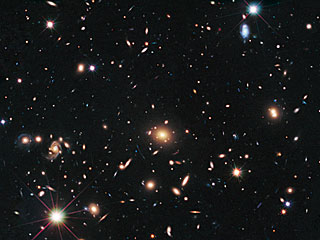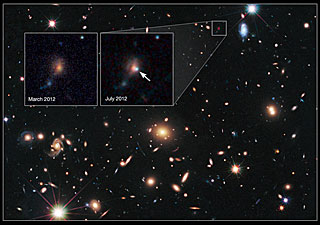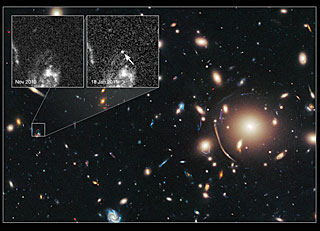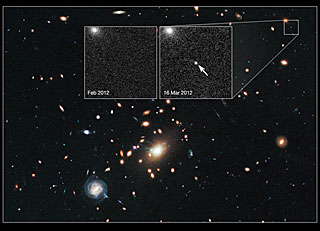Hubble astronomers check the prescription of a cosmic lens. First ever gravitationally lensed Type Ia supernovae discovered
Two teams of astronomers using the
NASA/ESA Hubble Space Telescope have discovered three distant exploding
stars that have been magnified by the immense gravity of foreground
galaxy clusters, which act like "cosmic lenses". These supernovae are
the first of their type ever to be observed magnified in this way and
they offer astronomers a powerful tool to check the prescription of
these massive lenses.
Massive clusters of galaxies act as “gravitational lenses” because their powerful gravity bends light passing through them [1].
This lensing phenomenon makes faraway objects behind the clusters
appear bigger and brighter — objects that might otherwise be too faint
to see, even with the largest telescopes.The new findings are the first steps towards the most precise prescription — or map — ever made for such a lens. How much a gravitationally lensed object is magnified depends on the amount of matter in a cluster — including dark matter, which we cannot see directly [2]. Astronomers develop maps that estimate the location and amount of dark matter lurking in a cluster. These maps are the lens prescriptions of a galaxy cluster and predict how distant objects behind a cluster will be magnified when their light passes through it. But how do astronomers know this prescription is accurate?
Now, two independent teams of astronomers from the Supernova Cosmology Project and the Cluster Lensing And Supernova survey with Hubble (CLASH) have found a new method to check the prescription of a gravitational lens. They analysed three supernovae — nicknamed Tiberius, Didius and Caracalla — which were each lensed by a different massive galaxy cluster — Abell 383, RXJ1532.9+3021 and MACS J1720.2+3536, respectively. Luckily, two and possibly all three of these supernovae appeared to be a special type of exploding star that can be used as a standard candle [3].
“Here, for the first time, we have found Type Ia supernovae that can be used like an eye chart for each lensing cluster,” explained Saurabh Jha of Rutgers University, USA, a member of the CLASH team. “Because we can estimate the intrinsic brightness of the Type Ia supernovae, we can independently measure the magnification of the lens, which is not possible with other background sources."
The teams measured the brightnesses of the lensed supernovae and compared them to the explosion's intrinsic brightness to calculate how much brighter the exploding stars' were made due to gravitational lensing. One supernova in particular stood out, appearing to be about twice as bright as would have been expected if not for the cluster's magnification power.
The three supernovae were discovered in the CLASH survey, which used Hubble to probe the distribution of dark matter in 25 galaxy clusters. Two of the supernovae were found in 2012; the other in 2010 to 2011.
To perform their analyses, both teams used Hubble observations alongside observations from both space and ground-based telescopes to provide independent estimates of the distances to these exploding stars [4].
In some cases the observations allowed direct confirmation of a Type Ia pedigree. In other cases the supernova spectrum was weak or overwhelmed by the light of its parent galaxy. In those cases the brightening and fading behaviour of the supernovae in different colours was used to help establish the supernova type.
Each team compared its results with independent theoretical models of the clusters' dark matter content. They each came to the same conclusions: that the predictions fit the models.
“It is encouraging that the two independent studies reach quite similar conclusions,” explained Supernova Cosmology Project team member Jakob Nordin of the E.O. Lawrence Berkeley National Laboratory (Berkeley Lab) and the University of California, Berkeley. “These pilot studies provide very good guidelines for making future observations of lensed supernovae even more accurate.” Nordin is the lead author on the team's science paper describing the findings.
The Supernova Cosmology Project's galaxy cluster models were created by team members Johan Richard of the University of Lyon in France, and Jean-Paul Kneib of Ecole Polytechnique Federale de Lausanne in Switzerland. “It’s really great to see that these supernovae are behaving in the way we expected,” says Kneib. “The more confirmation we get that our complex cluster models are correct, the more we can rely on them, and use them to probe the early Universe.”
“Building on our understanding of these lensing models also has implications for a wide range of key cosmological studies,” added Supernova Cosmology Project leader Saul Perlmutter of Berkeley Lab and the University of California, Berkeley. “These lens prescriptions yield measurements of the cluster masses, allowing us to probe the cosmic competition between gravity and dark energy as matter in the Universe gets pulled into galaxy clusters.” Dark energy being a mysterious and invisible energy that is accelerating the Universe's expansion.
The astronomers are optimistic that Hubble surveys such as Frontier Fields and future telescopes, including the infrared James Webb Space Telescope, will find more of these unique exploding stars. This is important as if you want to check the prescription of your lens, you really want to check it in more than one place. “Hubble is already hunting for them in the Frontier Fields, a three-year Hubble survey of the distant universe which uses massive galaxy clusters as gravitational lenses, to reveal what lies beyond them” said CLASH team member Brandon Patel of Rutgers University, the lead author on the science paper announcing the CLASH team's results.
The results from the CLASH team will appear in the May 2014 issue of The Astrophysical Journal. The Supernova Cosmology Project's findings will appear in the May 2014 edition of the Monthly Notices of the Royal Astronomical Society.
Notes
[1] Albert Einstein predicted this effect in his theory of general relativity.[2] Dark matter is believed to make up the bulk of the Universe's matter, and is therefore the source of most of a cluster's gravity.
[3] An astronomical "standard candle" is any type of luminous object whose intrinsic power is so accurately determined that it can be used to make distance measurements based on the rate the light dims over astronomical distances.
[4] The astronomers obtained observations in visible light from Hubble's Advanced Camera for Surveys and in infrared light from the Wide Field Camera 3.
Cosmic lens MACS J1720+35 helps Hubble to find a distant supernova

The heart of a vast cluster of galaxies called MACSJ1720+35 is shown
in this image, taken in visible and near-infrared light by the NASA/ESA
Hubble Space Telescope.
The galaxy cluster is so massive that its gravity distorts, brightens, and magnifies light from more distant objects behind it, an effect called gravitational lensing. In the top right an exploding star nicknamed Caracalla and located behind the cluster can just be made out.
The supernova is a member of a special class of exploding star called Type Ia, prized by astronomers because it provides a consistent level of peak brightness that makes it reliable for making distance estimates.
Finding a gravitationally lensed Type Ia supernova gives astronomers a unique opportunity to check the optical "prescription" of the foreground lensing cluster. The supernova is one of three exploding stars discovered in the Cluster Lensing And Supernova survey with Hubble (CLASH), and was followed up as part of a Supernova Cosmology Project HST program. CLASH is a Hubble census that probed the distribution of dark matter in 25 galaxy clusters. Dark matter cannot be seen directly but is believed to make up most of the universe's matter.
The image of the galaxy cluster was taken between March and July 2012 by Hubble's Wide Field Camera 3 and Advanced Camera for Surveys.
Credit:
NASA, ESA, S. Perlmutter (UC Berkeley, LBNL), A. Koekemoer (STScI), M. Postman (STScI), A. Riess (STScI/JHU), J. Nordin (LBNL, UC Berkeley), D. Rubin (Florida State), and C. McCully (Rutgers University)

The galaxy cluster is so massive that its gravity distorts, brightens, and magnifies light from more distant objects behind it, an effect called gravitational lensing. In the top right an exploding star nicknamed Caracalla and located behind the cluster can just be made out.
The supernova is a member of a special class of exploding star called Type Ia, prized by astronomers because it provides a consistent level of peak brightness that makes it reliable for making distance estimates.
Finding a gravitationally lensed Type Ia supernova gives astronomers a unique opportunity to check the optical "prescription" of the foreground lensing cluster. The supernova is one of three exploding stars discovered in the Cluster Lensing And Supernova survey with Hubble (CLASH), and was followed up as part of a Supernova Cosmology Project HST program. CLASH is a Hubble census that probed the distribution of dark matter in 25 galaxy clusters. Dark matter cannot be seen directly but is believed to make up most of the universe's matter.
The image of the galaxy cluster was taken between March and July 2012 by Hubble's Wide Field Camera 3 and Advanced Camera for Surveys.
Credit:
NASA, ESA, S. Perlmutter (UC Berkeley, LBNL), A. Koekemoer (STScI), M. Postman (STScI), A. Riess (STScI/JHU), J. Nordin (LBNL, UC Berkeley), D. Rubin (Florida State), and C. McCully (Rutgers University)
Cosmic lens MACS J1720+35 helps Hubble to find a distant supernova (annotated)

The heart of a vast cluster of galaxies called MACSJ1720+35 is shown
in this image, taken in visible and near-infrared light by the NASA/ESA
Hubble Space Telescope.
The galaxy cluster is so massive that its gravity distorts, brightens, and magnifies light from more distant objects behind it, an effect called gravitational lensing. The small white box at upper right marks the location of an exploding star, located behind the cluster.
An enlarged view of the supernova, nicknamed Caracalla, is shown in the furthest right of the two inset images, taken in July 2012. An arrow marks the location of the supernova, which resides near the bright core of the host galaxy. The supernova is seen as it appeared 7.7 billion years ago. The image was taken in near-infrared light with Hubble's Wide Field Camera 3.
The inset image on the left, taken in March 2012, shows the same region before the supernova blast. Astronomers combined observations taken in visible and near-infrared light with Hubble's Advanced Camera for Surveys and Wide Field Camera 3 to make the image. The supernova is a member of a special class of exploding star called Type Ia, prized by astronomers because it provides a consistent level of peak brightness that makes it reliable for making distance estimates.
Finding a gravitationally lensed Type Ia supernova gives astronomers a unique opportunity to check the optical "prescription" of the foreground lensing cluster. The supernova is one of three exploding stars discovered in the Cluster Lensing And Supernova survey with Hubble (CLASH), and was followed up as part of a Supernova Cosmology Project HST program. CLASH is a Hubble census that probed the distribution of dark matter in 25 galaxy clusters. Dark matter cannot be seen directly but is believed to make up most of the universe's matter.
The image of the galaxy cluster was taken between March and June 2012 by Hubble's Wide Field Camera 3 and Advanced Camera for Surveys.
Credit:
NASA, ESA, S. Perlmutter (UC Berkeley, LBNL), A. Koekemoer (STScI), M. Postman (STScI), A. Riess (STScI/JHU), J. Nordin (LBNL, UC Berkeley), D. Rubin (Florida State), and C. McCully (Rutgers University)

The galaxy cluster is so massive that its gravity distorts, brightens, and magnifies light from more distant objects behind it, an effect called gravitational lensing. The small white box at upper right marks the location of an exploding star, located behind the cluster.
An enlarged view of the supernova, nicknamed Caracalla, is shown in the furthest right of the two inset images, taken in July 2012. An arrow marks the location of the supernova, which resides near the bright core of the host galaxy. The supernova is seen as it appeared 7.7 billion years ago. The image was taken in near-infrared light with Hubble's Wide Field Camera 3.
The inset image on the left, taken in March 2012, shows the same region before the supernova blast. Astronomers combined observations taken in visible and near-infrared light with Hubble's Advanced Camera for Surveys and Wide Field Camera 3 to make the image. The supernova is a member of a special class of exploding star called Type Ia, prized by astronomers because it provides a consistent level of peak brightness that makes it reliable for making distance estimates.
Finding a gravitationally lensed Type Ia supernova gives astronomers a unique opportunity to check the optical "prescription" of the foreground lensing cluster. The supernova is one of three exploding stars discovered in the Cluster Lensing And Supernova survey with Hubble (CLASH), and was followed up as part of a Supernova Cosmology Project HST program. CLASH is a Hubble census that probed the distribution of dark matter in 25 galaxy clusters. Dark matter cannot be seen directly but is believed to make up most of the universe's matter.
The image of the galaxy cluster was taken between March and June 2012 by Hubble's Wide Field Camera 3 and Advanced Camera for Surveys.
Credit:
NASA, ESA, S. Perlmutter (UC Berkeley, LBNL), A. Koekemoer (STScI), M. Postman (STScI), A. Riess (STScI/JHU), J. Nordin (LBNL, UC Berkeley), D. Rubin (Florida State), and C. McCully (Rutgers University)
Cosmic lens Abell 383 helps Hubble to find a distant supernova (annotated)

The heart of a vast cluster of galaxies called Abell 383 is shown in
this image, taken in visible and near-infrared light by the NASA/ESA
Hubble Space Telescope.
The galaxy cluster is so massive that its gravity distorts, brightens, and magnifies light from more distant objects behind it, an effect called gravitational lensing. The small white box at left marks the location of an exploding star called a supernova, located behind the cluster.
An enlarged view of the supernova, nicknamed Tiberius after the first century Roman emperor, is shown in the furthest right inset image, taken in January 2011. The arrow pinpoints the supernova's location. The bright material beneath it is part of the host galaxy. The supernova is seen as it appeared 8 billion years ago.
The inset image on the left, taken in November 2010, shows the same region before the supernova blast.
Both inset images were taken in visible light with Hubble's Advanced Camera for Surveys.
The supernova is one of three exploding stars discovered in the Cluster Lensing And Supernova survey with Hubble (CLASH), and was followed up as part of a Supernova Cosmology Project HST program. CLASH is a Hubble census that probed the distribution of dark matter in 25 galaxy clusters. Dark matter cannot be seen directly but is believed to make up most of the universe's matter.
The image of the galaxy cluster was taken between November 2010 and February 2011 by Hubble's Wide Field Camera 3 and Advanced Camera for Surveys.
Credit:
NASA, ESA, C. McCully (Rutgers University), A. Koekemoer (STScI), M. Postman (STScI), A. Riess (STScI/JHU), S. Perlmutter (UC Berkeley, LBNL), J. Nordin (NBNL, UC Berkeley), and D. Rubin (Florida State)

The galaxy cluster is so massive that its gravity distorts, brightens, and magnifies light from more distant objects behind it, an effect called gravitational lensing. The small white box at left marks the location of an exploding star called a supernova, located behind the cluster.
An enlarged view of the supernova, nicknamed Tiberius after the first century Roman emperor, is shown in the furthest right inset image, taken in January 2011. The arrow pinpoints the supernova's location. The bright material beneath it is part of the host galaxy. The supernova is seen as it appeared 8 billion years ago.
The inset image on the left, taken in November 2010, shows the same region before the supernova blast.
Both inset images were taken in visible light with Hubble's Advanced Camera for Surveys.
The supernova is one of three exploding stars discovered in the Cluster Lensing And Supernova survey with Hubble (CLASH), and was followed up as part of a Supernova Cosmology Project HST program. CLASH is a Hubble census that probed the distribution of dark matter in 25 galaxy clusters. Dark matter cannot be seen directly but is believed to make up most of the universe's matter.
The image of the galaxy cluster was taken between November 2010 and February 2011 by Hubble's Wide Field Camera 3 and Advanced Camera for Surveys.
Credit:
NASA, ESA, C. McCully (Rutgers University), A. Koekemoer (STScI), M. Postman (STScI), A. Riess (STScI/JHU), S. Perlmutter (UC Berkeley, LBNL), J. Nordin (NBNL, UC Berkeley), and D. Rubin (Florida State)
Cosmic lens RXJ1532.9+3021 helps Hubble to find a distant supernova (annotated)

The heart of a vast cluster of galaxies called RXJ1532.9+3021 is
shown in this image, taken in visible and near-infrared light by the
ESA/NASA Hubble Space Telescope.
The galaxy cluster is so massive that its gravity distorts, brightens, and magnifies light from more distant objects behind it, an effect called gravitational lensing. The small white box at upper right marks the location of an exploding star called a supernova, located far behind the cluster.
An enlarged view of the supernova, nicknamed Didius after the second century Roman emperor Didius Julianus, is shown in the inset image on the right, taken in March 2012. The supernova is the white dot in the center of the image. The bright blob at upper left is the core of the host galaxy. The supernova is seen as it appeared 7 billion years ago.
The inset image on the left, taken in February 2012, shows the same region before the supernova blast. The supernova is a member of a special group of exploding stars called Type Ia, prized by astronomers because they provide a consistent level of peak brightness that makes them reliable for making distance estimates.
Both inset images were taken in visible light with Hubble’s Advanced Camera for Surveys.
Finding a gravitationally lensed Type Ia supernova gives astronomers a unique opportunity to check the optical "prescription" of the foreground lensing cluster. The supernova is one of three exploding stars discovered in the Cluster Lensing And Supernova survey with Hubble (CLASH), and was followed up as part of a Supernova Cosmology Project HST program. CLASH is a Hubble census that probed the distribution of dark matter in 25 galaxy clusters. Dark matter cannot be seen directly but is believed to make up most of the universe's matter.
The image of the galaxy cluster was taken between February and April 2012 by Hubble's Wide Field Camera 3 and Advanced Camera for Surveys.
Credit:
NASA, ESA, C. McCully (Rutgers University), A. Koekemoer (STScI), M. Postman (STScI), A. Riess (STScI/JHU), S. Perlmutter (UC Berkeley, LBNL), J. Nordin (NBNL, UC Berkeley), and D. Rubin (Florida State)
fuente: ESA/Hubble Information Centre
The galaxy cluster is so massive that its gravity distorts, brightens, and magnifies light from more distant objects behind it, an effect called gravitational lensing. The small white box at upper right marks the location of an exploding star called a supernova, located far behind the cluster.
An enlarged view of the supernova, nicknamed Didius after the second century Roman emperor Didius Julianus, is shown in the inset image on the right, taken in March 2012. The supernova is the white dot in the center of the image. The bright blob at upper left is the core of the host galaxy. The supernova is seen as it appeared 7 billion years ago.
The inset image on the left, taken in February 2012, shows the same region before the supernova blast. The supernova is a member of a special group of exploding stars called Type Ia, prized by astronomers because they provide a consistent level of peak brightness that makes them reliable for making distance estimates.
Both inset images were taken in visible light with Hubble’s Advanced Camera for Surveys.
Finding a gravitationally lensed Type Ia supernova gives astronomers a unique opportunity to check the optical "prescription" of the foreground lensing cluster. The supernova is one of three exploding stars discovered in the Cluster Lensing And Supernova survey with Hubble (CLASH), and was followed up as part of a Supernova Cosmology Project HST program. CLASH is a Hubble census that probed the distribution of dark matter in 25 galaxy clusters. Dark matter cannot be seen directly but is believed to make up most of the universe's matter.
The image of the galaxy cluster was taken between February and April 2012 by Hubble's Wide Field Camera 3 and Advanced Camera for Surveys.
Credit:
NASA, ESA, C. McCully (Rutgers University), A. Koekemoer (STScI), M. Postman (STScI), A. Riess (STScI/JHU), S. Perlmutter (UC Berkeley, LBNL), J. Nordin (NBNL, UC Berkeley), and D. Rubin (Florida State)
fuente: ESA/Hubble Information Centre


Comentarios